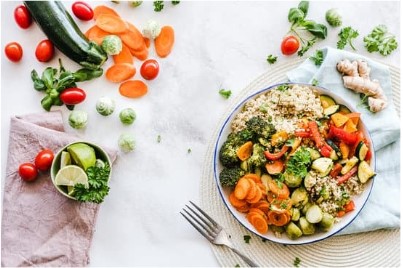As a registered dietitian, one of the most common questions I get is: “How can I create meals that are both nutritious and satisfying?” The answer lies in building a balanced plate. Whether you’re cooking at home, dining out, or packing a lunch, understanding how to structure your meals can make a world of difference for your health and energy levels. In this guide, I’ll walk you through the basics of building a balanced plate—it’s simpler than you might think!
The Balanced Plate Formula
A balanced plate is more than just calorie counting. It’s about incorporating the right proportions of macronutrients (carbohydrates, protein, and fat) and micronutrients (vitamins and minerals) to fuel your body. Here’s a straightforward formula to follow:
- Fill Half Your Plate with Vegetables and Fruits
Why: Vegetables and fruits are rich in vitamins, minerals, antioxidants, and fiber. They help support digestion, reduce inflammation, and provide long-lasting energy.
Examples: Leafy greens, broccoli, bell peppers, carrots, tomatoes, berries, apples, or oranges.
Tip: Aim for a variety of colors on your plate to ensure you’re getting a wide range of nutrients. - Reserve a Quarter of Your Plate for Lean Protein
Why: Protein is essential for building and repairing tissues, maintaining muscle mass, and keeping you full.
Examples: Grilled chicken, fish, tofu, beans, lentils, eggs, dairy, or the occasional red meat.
Tip: Choose plant-based proteins more often for added fiber and heart health benefits. - Use the Last Quarter for Whole Grains or Starchy Vegetables
Why: Carbohydrates are your body’s primary energy source, and whole grains or starchy vegetables provide sustained energy and additional fiber.
Examples: Brown rice, quinoa, sweet potatoes, whole-grain bread, or oatmeal.
Tip: Opt for whole grains over refined grains whenever possible to support blood sugar control and digestion. - Add Healthy Fats in Moderation
Why: Fats are critical for brain health, hormone production, and absorbing fat-soluble vitamins (A, D, E, and K).
Examples: Avocado, olive oil, nuts, seeds, or fatty fish like salmon.
Tip: A small drizzle of olive oil or a sprinkle of nuts can go a long way in enhancing flavor and nutrition.

Hydration Matters Too
Don’t forget to include water or other unsweetened beverages with your meal. Staying hydrated is key to overall health and can help prevent overeating, as thirst is often mistaken for hunger.
Balanced Plate in Practice
Here’s how you can put it all together:
- Breakfast: A bowl of oatmeal topped with fresh berries, a dollop of almond butter, and a side of scrambled eggs.
- Lunch: Grilled chicken salad with a variety of colorful vegetables, a scoop of tricolor quinoa mixed in, and a small handful of walnuts sprinkled on top.
- Dinner: Baked salmon, roasted sweet potatoes, and steamed broccoli with a drizzle of olive oil.
Flexible and Fun
The beauty of the balanced plate approach is its flexibility. You can adapt it to suit your dietary preferences, cultural cuisine, or food availability. Whether you’re vegan, gluten-free, or have other dietary needs, the principles remain the same.
Final Thoughts
Building a balanced plate doesn’t have to be complicated or restrictive. By focusing on variety, portion sizes, and nutrient-rich foods, you’ll create meals that nourish your body and keep you energized throughout the day. Start experimenting with these guidelines and notice how your meals—and how you feel—begin to transform!


